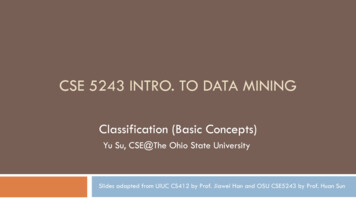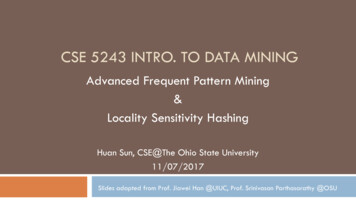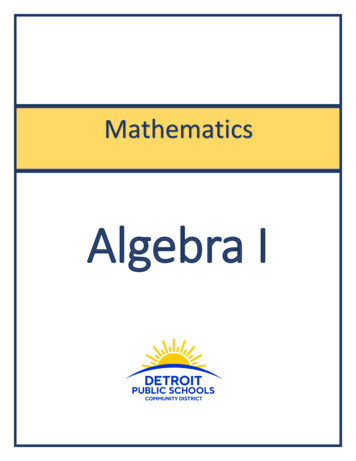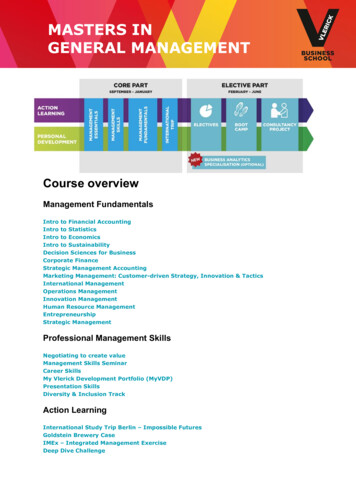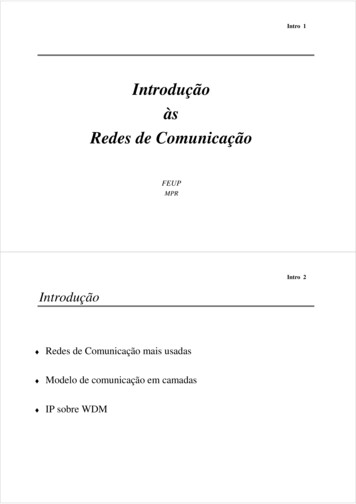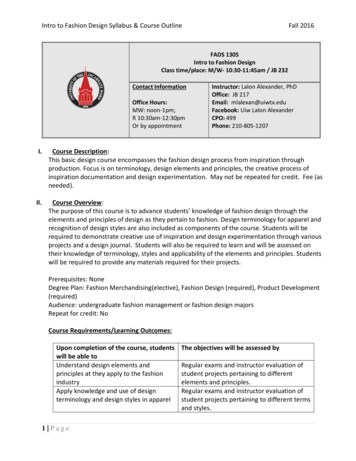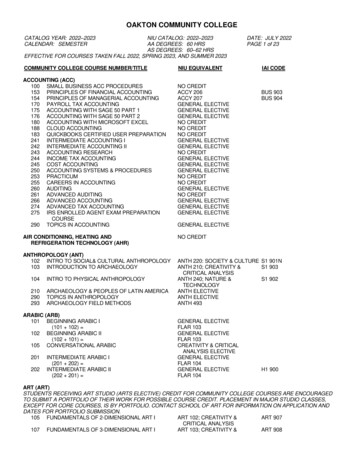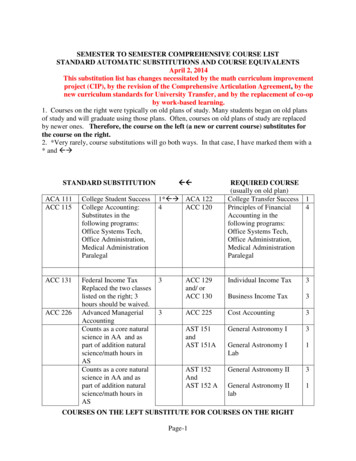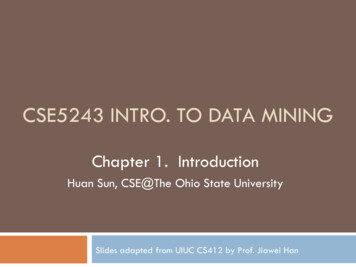
Transcription
CSE5243 INTRO. TO DATA MININGChapter 1. IntroductionHuan Sun, CSE@The Ohio State UniversitySlides adapted from UIUC CS412 by Prof. Jiawei Han
CSE 5243. Course Page & ScheduleClass Homepage:http://web.cse.ohio-state.edu/ sun.397/courses/au2018/cse5243-new.html Class Schedule:9:35-10:55 AM, Tue/Thur, Baker Systems 136Office hours: Instructor: Huan Sun @DL699, Tue 11:00AM-12:15PM (right after class)First week: No office hours 2Grader: TBD
CSE 5243. Textbook Textbook Jiawei Han, Micheline Kamber and Jian Pei, Data Mining: Concepts andTechniques (3rd ed), 2011 Pang-Ning Tan, Michael Steinbach, and Vipin Kumar, Introduction toData Mining, 2006 Mohammed J. Zaki and Wagner Meira, Jr., Data Mining Analysis andConcepts, 2014 Jure Leskovec, Anand Rajaraman, Jeff Ullman, Mining of MassiveDatasets 3More cs412/2. Course Syllabus and ScheduleMore resources: http://www.mmds.org/
CSE 5243. Course Work and Grading Homework, Course Projects, and Exams Participation: 10% (Online discussion and/or class participation)Homework: 50% (No Late Submissions!)Midterm exam: 20%Final exam: 20%Need help and/or discussions? Sign on: Piazza (https://piazza.com/osu/autumn2018/au185243/home) Check your homework/exam scores 4Receive credits: answering questions related to the homework on Piazza and engagingin class discussion.Carmen or Canvas: k
Chapter 1. Introduction5 What Is Data Mining? Why Data Mining? A Multi-Dimensional View of Data Mining What Kinds of Data Can Be Mined? What Kinds of Patterns Can Be Mined? What Kinds of Technologies Are Used? What Kinds of Applications Are Targeted? Major Issues in Data Mining A Brief History of Data Mining and Data Mining Society Summary
What is Data Mining? Data mining (knowledge discovery from data, KDD) Extraction of interesting (non-trivial, implicit, previouslyunknown and potentially useful) patterns or knowledgefrom huge amount of data Data mining: a misnomer?Alternative names 6Knowledge discovery (mining) in databases (KDD),knowledge extraction, data/pattern analysis, dataarcheology, data dredging, information harvesting,business intelligence, etc.
Knowledge Discovery (KDD) Process This is a view from typicaldatabase systems and datawarehousing communitiesPatternEvaluationData mining plays an essentialrole in the knowledge discoveryprocessDataMiningTask-relevant DataData WarehouseData Cleaning7SelectionData IntegrationDatabases
Example: A Web Mining Framework Web mining usually involves Datacleaning Dataintegration from multiple sources Warehousingthe data Datacube construction Dataselection for data mining Datamining Presentation Patternsof the mining resultsand knowledge to be used or stored intoknowledge-base8
Data Mining in Business IntelligenceIncreasing potentialto supportbusiness decisionsDecisionMakingData PresentationVisualization TechniquesData MiningInformation DiscoveryEnd UserBusinessAnalystDataAnalystData ExplorationStatistical Summary, Querying, and ReportingData Preprocessing/Integration,Data WarehousesData SourcesPaper, documents, Scientific experiments, Database Systems9DBA
KDD Process: A View from ML and StatisticsInput DataDataPreProcessingData integrationNormalizationFeature selectionDimensionreduction PostProcessingPattern discoveryClassificationClusteringOutlier analysis erpretationvisualizationThis is a view from typical machine learning and statisticscommunities10DataMining
Chapter 1. Introduction11 What Is Data Mining? Why Data Mining? A Multi-Dimensional View of Data Mining What Kinds of Data Can Be Mined? What Kinds of Patterns Can Be Mined? What Kinds of Technologies Are Used? What Kinds of Applications Are Targeted? Major Issues in Data Mining A Brief History of Data Mining and Data Mining Society Summary
Why Data Mining? The Explosive Growth of Data: from terabytes to petabytes Data collection and data availability 12Automated data collection tools, database systems, Web,computerized society
Why Data Mining? The Explosive Growth of Data: from terabytes to petabytes Data collection and data availability 13Automated data collection tools, database systems, Web,computerized societyMajor sources of abundant data Business: Web, e-commerce, transactions, stocks, Science: Remote sensing, bioinformatics, scientific simulation, Society and everyone: news, digital cameras, YouTube
Why Data Mining? The Explosive Growth of Data: from terabytes to petabytes Data collection and data availability 14Automated data collection tools, database systems, Web,computerized societyMajor sources of abundant data Business: Web, e-commerce, transactions, stocks, Science: Remote sensing, bioinformatics, scientific simulation, Society and everyone: news, digital cameras, YouTubeWe are drowning in data, but starving for knowledge!“Necessity is the mother of invention”—Data mining—Automatedanalysis of massive data sets
Chapter 1. Introduction15 Why Data Mining? What Is Data Mining? A Multi-Dimensional View of Data Mining What Kinds of Data Can Be Mined? What Kinds of Patterns Can Be Mined? What Kinds of Technologies Are Used? What Kinds of Applications Are Targeted? Major Issues in Data Mining A Brief History of Data Mining and Data Mining Society Summary
Multi-Dimensional View of Data Mining Data to be mined 16Database data (extended-relational, object-oriented, heterogeneous), datawarehouse, transactional data, stream, spatiotemporal, time-series, sequence, textand web, multi-media, graphs & social and information networks
Multi-Dimensional View of Data Mining Data to be mined 17Database data (extended-relational, object-oriented, heterogeneous), datawarehouse, transactional data, stream, spatiotemporal, time-series, sequence, textand web, multi-media, graphs & social and information networksKnowledge to be mined (or: Data mining functions) Characterization, discrimination, association, classification, clustering,trend/deviation, outlier analysis, Descriptive vs. predictive data mining Multiple/integrated functions and mining at multiple levels
Multi-Dimensional View of Data Mining Data to be mined Knowledge to be mined (or: Data mining functions) Characterization, discrimination, association, classification, clustering,trend/deviation, outlier analysis, Descriptive vs. predictive data mining Multiple/integrated functions and mining at multiple levelsTechniques utilized 18Database data (extended-relational, object-oriented, heterogeneous), datawarehouse, transactional data, stream, spatiotemporal, time-series, sequence, textand web, multi-media, graphs & social and information networksData-intensive, data warehouse (OLAP), machine learning, statistics, patternrecognition, visualization, high-performance, etc.
Multi-Dimensional View of Data Mining Data to be mined Knowledge to be mined (or: Data mining functions) Characterization, discrimination, association, classification, clustering,trend/deviation, outlier analysis, Descriptive vs. predictive data mining Multiple/integrated functions and mining at multiple levelsTechniques utilized Data-intensive, data warehouse (OLAP), machine learning, statistics, patternrecognition, visualization, high-performance, etc.Applications adapted 19Database data (extended-relational, object-oriented, heterogeneous), datawarehouse, transactional data, stream, spatiotemporal, time-series, sequence, textand web, multi-media, graphs & social and information networksRetail, telecommunication, banking, fraud analysis, bio-data mining, stock marketanalysis, text mining, Web mining, etc.
Chapter 1. Introduction20 Why Data Mining? What Is Data Mining? A Multi-Dimensional View of Data Mining What Kinds of Data Can Be Mined? What Kinds of Patterns Can Be Mined? What Kinds of Technologies Are Used? What Kinds of Applications Are Targeted? Major Issues in Data Mining A Brief History of Data Mining and Data Mining Society Summary
Data Mining: On What Kinds of Data? 21Database-oriented data sets and applications Relational database, data warehouse, transactional database Object-relational databases, Heterogeneous databases and legacydatabasesAdvanced data sets and advanced applications Data streams and sensor data Time-series data, temporal data, sequence data (incl. bio-sequences) Structure data, graphs, social networks and information networks Spatial data and spatiotemporal data Multimedia database Text databases The World-Wide Web
Chapter 1. Introduction22 Why Data Mining? What Is Data Mining? A Multi-Dimensional View of Data Mining What Kinds of Data Can Be Mined? What Kinds of Patterns Can Be Mined? What Kinds of Technologies Are Used? What Kinds of Applications Are Targeted? Major Issues in Data Mining A Brief History of Data Mining and Data Mining Society Summary
Data Mining Functions: Pattern Discovery 23Frequent patterns (or frequent itemsets) What items are frequently purchased together in your Walmart?
Data Mining Functions: Pattern Discovery 24Frequent patterns (or frequent itemsets) What items are frequently purchased together in your Walmart?Association and Correlation Analysis
Data Mining Functions: Pattern Discovery Frequent patterns (or frequent itemsets) What items are frequently purchased together in your Walmart?Association and Correlation AnalysisA typical association ruleDiaper Beer [0.5%, 75%] (support, confidence) Are strongly associated items also strongly correlated?How to mine such patterns and rules efficiently in large datasets?How to use such patterns for classification, clustering, and otherapplications? 25
Data Mining Functions: Classification 26Classification and label prediction Construct models (functions) based on some training examples Describe and distinguish classes or concepts for future prediction Ex. 1. Classify countries based on (climate) Ex. 2. Classify cars based on (gas mileage) Predict some unknown class labels
Data Mining Functions: Classification 27Classification and label prediction Construct models (functions) based on some training examples Describe and distinguish classes or concepts for future prediction Ex. 1. Classify countries based on (climate) Ex. 2. Classify cars based on (gas mileage) Predict some unknown class labelsTypical methods Decision trees, naïve Bayesian classification, support vectormachines, neural networks, rule-based classification, patternbased classification, logistic regression,
Data Mining Functions: Classification 28Classification and label prediction Construct models (functions) based on some training examples Describe and distinguish classes or concepts for future prediction Ex. 1. Classify countries based on (climate) Ex. 2. Classify cars based on (gas mileage) Predict some unknown class labelsTypical methods Decision trees, naïve Bayesian classification, support vectormachines, neural networks, rule-based classification, patternbased classification, logistic regression, Typical applications: Credit card fraud detection, direct marketing, classifying stars,diseases, web-pages,
Data Mining Functions: Cluster Analysis 29Unsupervised learning (i.e., Classlabel is unknown)Group data to form newcategories (i.e., clusters), e.g.,cluster houses to find distributionpatterns
Data Mining Functions: Cluster Analysis 30Unsupervised learning (i.e., Classlabel is unknown)Group data to form newcategories (i.e., clusters), e.g.,cluster houses to find distributionpatternsPrinciple: Maximizing intra-classsimilarity & minimizing interclasssimilarityMany methods and applications
Data Mining Functions: Outlier Analysis 31Outlier analysis Outlier: A data object that does not comply with thegeneral behavior of the data Noise or exception?―One person’s garbage couldbe another person’s treasure
Data Mining Functions: Outlier Analysis 32Outlier analysis Outlier: A data object that does not comply with thegeneral behavior of the data Noise or exception?―One person’s garbage couldbe another person’s treasure Methods: by product of clustering or regressionanalysis, Useful in fraud detection, rare events analysis
Data Mining Functions: Time and Ordering:Sequential Pattern, Trend and Evolution Analysis 33Sequence, trend and evolution analysis Trend, time-series, and deviation analysis e.g., regression and value prediction Sequential pattern mining e.g., buy digital camera, then buy largememory cards Periodicity analysis Motifs and biological sequence analysis Approximate and consecutive motifs Similarity-based analysisMining data streams Ordered, time-varying, potentially infinite, datastreams
Data Mining Functions: Structure andNetwork Analysis 34Graph mining Finding frequent subgraphs (e.g., chemical compounds), trees (XML),substructures (web fragments)
Data Mining Functions: Structure andNetwork Analysis 35Graph mining Finding frequent subgraphs (e.g., chemical compounds), trees (XML),substructures (web fragments)Information network analysis Social networks: actors (objects, nodes) and relationships (edges) e.g., author networks in CS, terrorist networks Multiple heterogeneous networks A person could be multiple information networks: friends, family,classmates, Links carry a lot of semantic information: Link mining
Data Mining Functions: Structure andNetwork Analysis 36Graph mining Finding frequent subgraphs (e.g., chemical compounds), trees (XML),substructures (web fragments)Information network analysis Social networks: actors (objects, nodes) and relationships (edges) e.g., author networks in CS, terrorist networks Multiple heterogeneous networks A person could be multiple information networks: friends, family,classmates, Links carry a lot of semantic information: Link miningWeb mining Web is a big information network: from PageRank to Google Analysis of Web information networks Web community discovery, opinion mining, usage mining,
Evaluation of Knowledge 37Are all mined knowledge interesting? One can mine tremendous amount of “patterns” Some may fit only certain dimension space (time, location, ) Some may not be representative, may be transient,
Evaluation of Knowledge 38Are all mined knowledge interesting? One can mine tremendous amount of “patterns” Some may fit only certain dimension space (time, location, ) Some may not be representative, may be transient, Evaluation of mined knowledge directly mine only interestingknowledge? Descriptive vs. predictive Coverage Typicality vs. novelty Accuracy Timeliness
Chapter 1. Introduction39 Why Data Mining? What Is Data Mining? A Multi-Dimensional View of Data Mining What Kinds of Data Can Be Mined? What Kinds of Patterns Can Be Mined? What Kinds of Technologies Are Used? What Kinds of Applications Are Targeted? Major Issues in Data Mining A Brief History of Data Mining and Data Mining Society Summary
Data Mining: Confluence of Multiple atternRecognitionData h-PerformanceComputing
Why Confluence of Multiple Disciplines? 41Tremendous amount of data Algorithms must be scalable to handle big dataHigh-dimensionality of data Micro-array may have tens of thousands of dimensionsHigh complexity of data Data streams and sensor data Time-series data, temporal data, sequence data Structure data, graphs, social and information networks Spatial, spatiotemporal, multimedia, text and Web data Software programs, scientific simulationsNew and sophisticated applications
Chapter 1. Introduction42 Why Data Mining? What Is Data Mining? A Multi-Dimensional View of Data Mining What Kinds of Data Can Be Mined? What Kinds of Patterns Can Be Mined? What Kinds of Technologies Are Used? What Kinds of Applications Are Targeted? Major Issues in Data Mining A Brief History of Data Mining and Data Mining Society Summary
Applications of Data Mining Web page analysis: classification, clustering, ranking Collaborative analysis & recommender systems Biological and medical data analysis Data mining and software engineering Data mining and text analysis Data mining and social and information network analysis 43Built-in (invisible data mining) functions in Google, MS, Yahoo!,Linked, Facebook,
Chapter 1. Introduction44 Why Data Mining? What Is Data Mining? A Multi-Dimensional View of Data Mining What Kinds of Data Can Be Mined? What Kinds of Patterns Can Be Mined? What Kinds of Technologies Are Used? What Kinds of Applications Are Targeted? Major Issues in Data Mining A Brief History of Data Mining and Data Mining Society Summary
Major Issues in Data Mining (1) 45Mining Methodology Mining various and new kinds of knowledge Mining knowledge in multi-dimensional space Data mining: An interdisciplinary effort Boosting the power of discovery in a networked environment Handling noise, uncertainty, and incompleteness of data Pattern evaluation and pattern- or constraint-guided mining
Major Issues in Data Mining (1) 46Mining Methodology Mining various and new kinds of knowledge Mining knowledge in multi-dimensional space Data mining: An interdisciplinary effort Boosting the power of discovery in a networked environment Handling noise, uncertainty, and incompleteness of data Pattern evaluation and pattern- or constraint-guided miningUser Interaction Interactive mining Incorporation of background knowledge Presentation and visualization of data mining results
Major Issues in Data Mining (2) 47Efficiency and Scalability Efficiency and scalability of data mining algorithms Parallel, distributed, stream, and incremental mining methodsDiversity of data types Handling complex types of data Mining dynamic, networked, and global data repositoriesData mining and society Social impacts of data mining Privacy-preserving data mining
Chapter 1. Introduction48 Why Data Mining? What Is Data Mining? A Multi-Dimensional View of Data Mining What Kinds of Data Can Be Mined? What Kinds of Patterns Can Be Mined? What Kinds of Technologies Are Used? What Kinds of Applications Are Targeted? Major Issues in Data Mining A Brief History of Data Mining and Data Mining Society Summary
A Brief History of Data Mining Society 491989 IJCAI Workshop on Knowledge Discovery in Databases Knowledge Discovery in Databases (G. Piatetsky-Shapiro and W.Frawley, 1991)1991-1994 Workshops on Knowledge Discovery in Databases Advances in Knowledge Discovery and Data Mining (U. Fayyad, G.Piatetsky-Shapiro, P. Smyth, and R. Uthurusamy, 1996)1995-1998 International Conferences on Knowledge Discovery inDatabases and Data Mining (KDD’95-98) Journal of Data Mining and Knowledge Discovery (1997)ACM SIGKDD conferences since 1998 and SIGKDD ExplorationsMore conferences on data mining PAKDD (1997), PKDD (1997), SIAM-Data Mining (2001), (IEEE) ICDM(2001), WSDM (2008), etc.ACM Transactions on KDD (2007)
Conferences and Journals on Data Mining 50KDD Conferences ACM SIGKDD Int. Conf. onKnowledge Discovery inDatabases and Data Mining (KDD) SIAM Data Mining Conf. (SDM) (IEEE) Int. Conf. on Data Mining(ICDM) European Conf. on MachineLearning and Principles andpractices of Knowledge Discoveryand Data Mining (ECML-PKDD) Pacific-Asia Conf. on KnowledgeDiscovery and Data Mining(PAKDD) Int. Conf. on Web Search andData Mining (WSDM) Other related conferences DB conferences: ACM SIGMOD,VLDB, ICDE, EDBT, ICDT, Web and IR conferences:WWW, SIGIR, WSDM ML conferences: ICML, NIPS PR conferences: CVPR,Journals Data Mining and KnowledgeDiscovery (DAMI or DMKD) IEEE Trans. On Knowledge andData Eng. (TKDE) KDD Explorations ACM Trans. on KDD
Where to Find References? DBLP, CiteSeer, Google 51Data mining and KDD (SIGKDD) Conferences: ACM-SIGKDD, IEEE-ICDM, SIAM-DM, PKDD, PAKDD, etc. Journal: Data Mining and Knowledge Discovery, KDD Explorations, ACMTKDDDatabase systems (SIGMOD) Conferences: ACM-SIGMOD, ACM-PODS, VLDB, IEEE-ICDE, EDBT, ICDT,DASFAA Journals: IEEE-TKDE, ACM-TODS/TOIS, JIIS, J. ACM, VLDB J., Info. Sys., etc.AI & Machine Learning Conferences: Machine learning (ML), AAAI, IJCAI, COLT (Learning Theory),CVPR, NIPS, etc. Journals: Machine Learning, Artificial Intelligence, Knowledge andInformation Systems, IEEE-PAMI, etc.
Where to Find References? DBLP, CiteSeer, Google 52Web and IR Conferences: SIGIR, WWW, CIKM, etc. Journals: WWW: Internet and Web Information SystemsStatistics Conferences: Joint Stat. Meeting, etc. Journals: Annals of statistics, etc.Visualization Conference proceedings: CHI, ACM-SIGGraph, etc. Journals: IEEE Trans. visualization and computer graphics, etc.
Chapter 1. Introduction53 Why Data Mining? What Is Data Mining? A Multi-Dimensional View of Data Mining What Kinds of Data Can Be Mined? What Kinds of Patterns Can Be Mined? What Kinds of Technologies Are Used? What Kinds of Applications Are Targeted? Major Issues in Data Mining A Brief History of Data Mining and Data Mining Society Summary
Summary 54Data mining: Discovering interesting patterns and knowledge frommassive amount of dataA natural evolution of science and information technology, in greatdemand, with wide applicationsA KDD process includes data cleaning, data integration, dataselection, transformation, data mining, pattern evaluation, andknowledge presentationMining can be performed in a variety of dataData mining functionalities: characterization, discrimination,association, classification, clustering, trend and outlier analysis, etc. Data mining technologies and applications Major issues in data mining
Recommended Reference Books 55Charu C. Aggarwal, Data Mining: The Textbook, Springer, 2015E. Alpaydin. Introduction to Machine Learning, 2nd ed., MIT Press, 2011R. O. Duda, P. E. Hart, and D. G. Stork, Pattern Classification, 2ed., WileyInterscience, 2000U. Fayyad, G. Grinstein, and A. Wierse, Information Visualization in Data Miningand Knowledge Discovery, Morgan Kaufmann, 2001J. Han, M. Kamber, and J. Pei, Data Mining: Concepts and Techniques. MorganKaufmann, 3rd ed. , 2011T. Hastie, R. Tibshirani, and J. Friedman, The Elements of Statistical Learning:Data Mining, Inference, and Prediction, 2nd ed., Springer, 2009T. M. Mitchell, Machine Learning, McGraw Hill, 1997P.-N. Tan, M. Steinbach and V. Kumar, Introduction to Data Mining, Wiley, 2005(2nd ed. 2016)I. H. Witten and E. Frank, Data Mining: Practical Machine Learning Tools andTechniques with Java Implementations, Morgan Kaufmann, 2nd ed. 2005Mohammed J. Zaki and Wagner Meira Jr., Data Mining and Analysis:Fundamental Concepts and Algorithms 2014
56Preview for Next Classhttp://web.cse.ohiostate.edu/ sun.397/courses/au2017/cse5243new.html
Jure Leskovec, Anand Rajaraman, Jeff Ullman, Mining of Massive Datasets . "Necessity is the mother of invention"—Data mining—Automated analysis of massive data sets. 15 Chapter 1. Introduction
